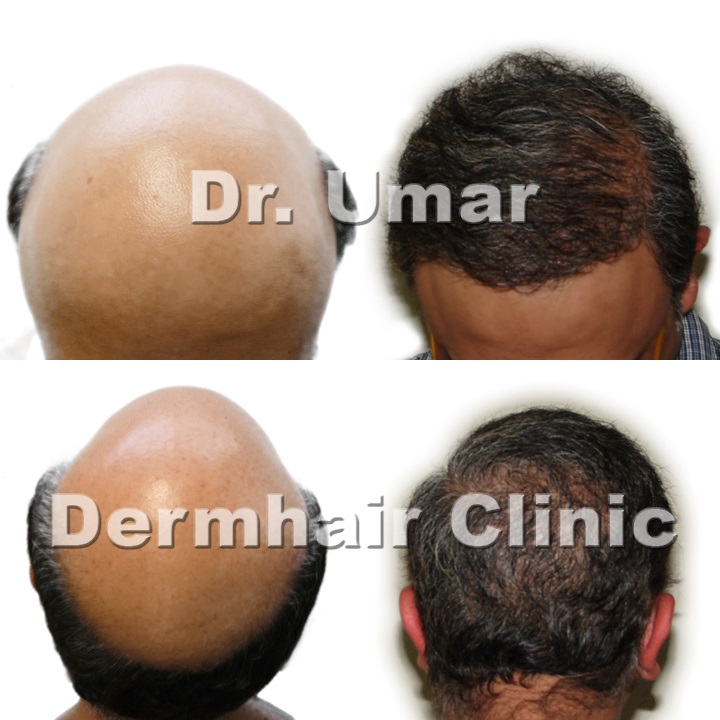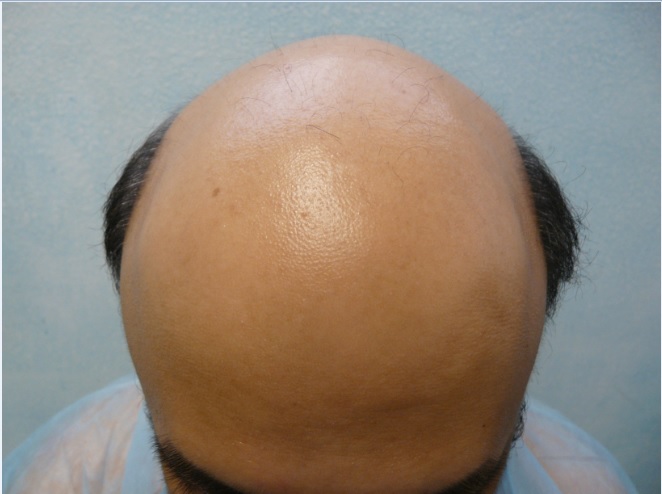- how the stable zone of hairs are defined by each doctor
- whether the doctor will focus on density versus fullness for a hair transplant procedure
- whether or not body hair follicles can be used as grafts for the hair transplant.
- Patient hair color. Darker colors require more higher graft counts
- Hair caliber: thicker hair covers better
- Skin color. The less the hair to skin color contrast the lesser number of grafts you would need
Leading FUE hair transplant specialist, Dr. Umar believes in becoming familiar with these possible explanations so that the different graft count estimate can make better sense to you.
Determining The Stable Zone For A Hair Transplantation Procedure
The stable zone of grafts are the follicles which are resilient to the effects of DHT. Therefore, these hairs can be counted on to last long term.
DHT is produced in everyone as a breakdown product of testosterone. However, whether or not it causes hair loss will be determined by the nature of protein receptors on the hair follicles. Genes determine how these receptors are structured and whether or not they will be able to protect the follicle against the effects of DHT.
Individuals with pattern baldness have inherited DNA sequences which resulted in sensitive protein receptors. This creates structural vulnerabilities in the way certain androgen protein receptors on the follicles are built. Therefore, they are less able to ward off the damaging effects of DHT. When this compound binds to the receptors, limited amounts of oxygen and nutrients are able to be absorbed by the follicles. As a result, they starve and miniaturize.
A hair transplant surgeon needs to discern between stable hair follicles and ones that are sensitive to DHT.
According to Dr. Umar, it is more difficult to determine the stable zone of hairs in younger patients. These individuals are still in the process of losing hair at a rapid rate. This ambiguity makes the identification of appropriate grafts a more subjective process from one doctor to another.
Through a general assessment, one hair transplant doctor may perceive a very conservative number of stable donor hairs. Another may define a more liberal quantity of donor hairs on the head. So this can explain the different graft counts given by different people.
The stable zone becomes more clear, objective and apparent in later stages of an individual’s hair loss condition.
Choosing Density Versus Fullness For Coverage Influences Different Graft Count Estimates
Achieving a patient’s objectives can be a matter of:
(1) creating a particular density level
(2) the desired appearance of fullness.
The original density of one’s youth may or may not be restored during a hair transplant procedure. Inserting a high number of follicular units per square centimeter can be detrimental for growth yield. Most doctors consider a density of 30 fu/cm2 to be a safe level.
However natural densities are often much higher. Some surgeons are comfortable with the creation of larger densities. Therefore, they will provide higher donor graft estimates.
Other surgeons may want to take a more conservative approach to ensure quality yield. They will likely quote much smaller graft counts. However, they may also be able to use other strategies to create a fuller looking appearance. For example, inserting the grafts at sharper angles, closer to the surface of the skin can result in an appearance with greater looking coverage.
The Use of Body Hair Transplant Methods
Another source of discrepancies in estimated graft count can result from the use of body hair. Naturally, a hair restoration doctor would be clear about their ability to use these grafts up front. So there should not be confusion as to why their quote is much higher than other clinics.
Here at Dermhair Clinic, Dr. Umar uses specialized hair transplant tools and methodologies in Advanced Follicular Unit Extraction, to harvest donor follicles from body areas areas such as:
- beard regions of the neck and face
- chest
- abdomen
- shoulders
- legs and thighs
- arms
Therefore, a much greater donor pool can be compiled compared to using head sources alone.
By understanding the reasons behind different graft count estimates, it is possible to refine your expectations on density, the use of body hair and the timing of the hair transplantation surgery.

Learn to estimate your hair transplant surgery number of grafts ahead of your consultation

